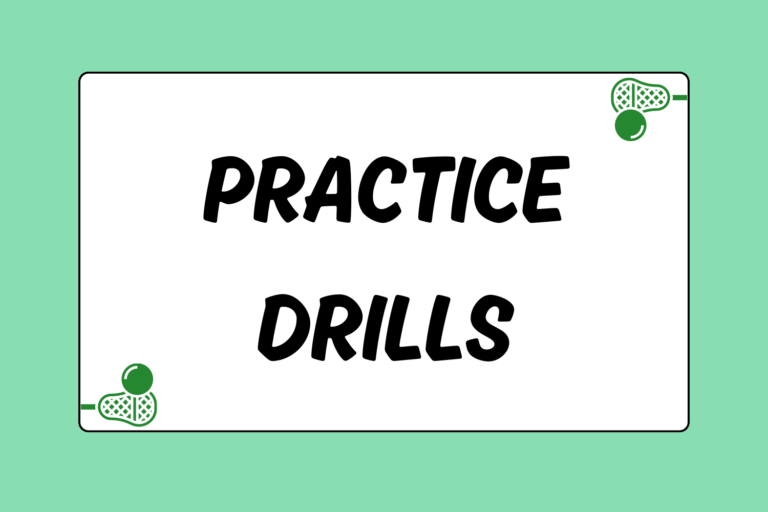Proper execution of a fast break can be a real momentum changer in a lacrosse game. If done correctly, this is one of the surest and easiest ways a team can get a quick goal and secure some momentum for their side. Since you won’t always be able to score a ton of goals in the settled offense, taking advantage of transition opportunities is crucial to your team putting up enough points to win a game.
A 4-on-3 fast break almost always involves a midfielder streaking down the field, meeting up with his three attackmen and creating a quick mismatch against his opponent’s three defensemen. Offensively, players will want to maintain proper spacing and positioning to place themselves in good scoring areas and prevent the defense from having easy slides. The offense’s goal in a fast-break opportunity is to create a good scoring chance through quick ball movement before the defensive players have a chance to get down the field and get setup.
Proper Positioning
When the attack recognizes the fast break opportunity, they set up in what is called an “L-break.” It’s called an L-break because the three attackmen will set up in a formation that looks like an “L” if viewed from overhead. The best passer of the three will play what is called “point,” and will set up about 12 yards up field from the goal, and on the opposite hash mark from the side the ball carrier is breaking down. The ball carrier must be sure to angle his run towards the pipe of the goal on the side of the field he is running down, and not to run down the exact middle of the field. The remaining two attackmen will have set up low right, and low left on goal-line extended (GLE). The low attackman on the point side will position himself immediately next to the crease, forcing one of the defensemen to stay home with him until the ball moves to the point. The opposite low attackman will set up about five yards away from the crease on the ball carrier’s side of the field, still on GLE.
Ball Movement
The first and most important part of the fast break is for the midfielder to draw the “point” defenseman to him as he runs toward the goal. The ball carrier should take the approach that he is going hard to the cage and looking to shoot anywhere inside 10 yards from the goal until a defender is in proper position to stop him. If no defender commits to stopping the ball, the carrier should look for his own shot.
Once the point defender has fully committed to the slide, the ball carrier should pass the ball quickly and accurately to the point attackman. Now that the defense is rotating as a unit, the ball should move quickly in the opposite direction of the defensive rotation in order to take advantage of the unsettled defense. The point man will move his feet toward the oncoming pass and turn his hips and chest toward the goal upon receiving the pass. This will allow the point man to quickly see his teammates and easily make a decision about where to pass the ball.
The first look for the point man is to pass the ball to the low point side attackman. This attackman should break away from the goal as the ball is being passed to the point. This is done to create space for himself to be able to dodge or pass the ball once he catches the pass. If the defense is not timing its slides properly, the point can make a diagonal pass to the low off-side attackman. Usually though, the point will want to move the ball to the low point-side attackman.
As the low point-side attackman readies to catch the pass from the point, his hips should be facing up field, towards the point man, and he should take one or two steps in the direction of the ball. Once he has caught the ball, he should turn his hips toward the middle of the field to the area in front of the goal and decide quickly what he will do with the ball.
His first option is to simply set his feet and shoot from the spot he catches the ball.
The second and probably best option is for the low-point side attackman to dodge to the front of the goal. Low-point side is a great place to begin a dodge from. A defender is generally running towards this attackman from across the crease as he catches the ball, and he has time to see the oncoming defender and make his move. He can either show some stick (by setting his feet and acting like he’s going to shoot) when he catches, and face dodge underneath the defender; or he can tuck the stick and protect, absorbing a check and curling over the defender for a better look at the cage. Roll dodges are not recommended on a fast break, because they take longer to execute and they require not having your eyes focused on your teammates for a second or two.
The third and final option for this attackman is to pass the ball cross-crease to the other low attackman, who should be following about five yards behind the sliding defender and coming to the front of the goal for an easy shot. Whatever this attackman chooses to do with the ball, his footwork is the key to a successful move.
If the offense is able to execute two consecutive hard and accurate passes, it should almost always result in a scoring chance from in close. The key is to get the ball to that low point-side attackman. The team’s best right-hand finishing attackman should occupy that position.
The low off-point side attackman is used to keep the defense spaced out. More often than not, that attackman will not even touch the ball on a fast break. However, if and when the low off-point-side attackman catches the ball, he will almost always want to shoot, as he generally will be somewhere very near the goal with defenders not in his immediate area.
5 Musts on Fast Breaks
- Be a threat: If you have the ball in your stick, look to get to the cage until a defender is in position to stop you.
- Always move the ball quickly and efficiently.
- Always move your feet.
- Never face away from the middle of the field.
- Keep your body between your stick and the goal.
Finishing
Once you get the ball in a good place to shoot, it’s important to be efficient and not waste any time or movement. If you have the chance to throw a fake on the goalie from in close, be sure to limit it to one move. More than one fake takes a lot more time (giving defenders a chance to recover and check you) and increases the likelihood that you will lose the ball. You can fake to the top-shelf quite easily by simultaneously moving your head and hands upward just a tick. The goal with a fake like that is that the goalie raises his hands and stick along with yours and opens up the lower half of the cage for an easy finish.
Another thing to remember when finishing is to pay attention to how the goalie is moving. If you’ve just caught a cross-crease pass, the goalie will also be moving cross-crease with the ball and won’t have his feet set to step to the ball and make a quick save. This is a great time to shoot to the opposite pipe, since the goalie will be moving away from it.
Momentum is Everything
Scoring on the fast break is a great way to build momentum in a game, and really take the air out of the other team’s sails. Proper spacing and understanding of defensive principles on the break will lead to easy goals and happy moments for the offense.





